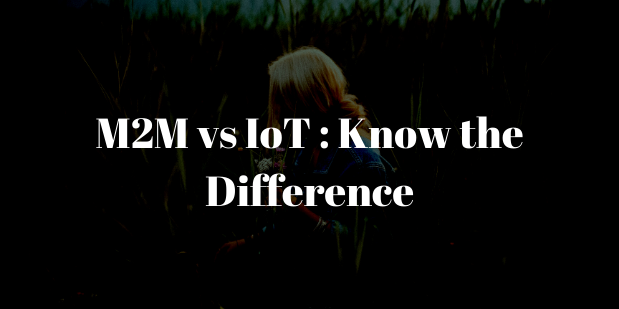M2M vs IoT : Know the Difference

The distinction between Machine to Machine and Internet of Things can be confusing. In fact many people are under the misconception that M2M and IoT are the same and have been a continuing subject of every realistic discussion. Both the technologies have been evolving at a constant speed and it’s really important to find the right difference between both of them. The confusion started because both M2M and IoT boasted of remote device access. While both are connectivity solutions for enterprise, they are each two different schools of solution. M2M and IoT connect different things but achieve connectivity differently. So, let us first take a look where both technologies overlap.
Remote Access
M2M is the predecessor of IoT. When M2M was launched it has set the foundations of machine connectivity on which IoT improved on, IoT development takes place and is practically built on. So, we can say that IoT is the bigger vision on connectivity that is fueled by the advancements of M2M applications. But M2M is the first and foremost, a business solution that connects businesses to their likewise connected machines.
M2M revolutionizes business operations by enabling them to monitor and manage their machines or pieces of equipment remotely. It’s main feature is to connect a device to the cloud so that business can manage that device and collect data from it remotely. However, IoT is a mass market technology that applies to both consumers and enterprises. Consumers IoT connects people to their devices and similarly, allows for remote control over those devices.
Improvement of Business Performance
The most important application of both these technologies is its data centricity. Because of the provided connectivity, data from these devices can be gleaned for feedback on it’s performance, user experience, and maintenance. M2M systems are used to locate system errors and cut down on maintenance costs by eliminating the need of constant manual upkeep.
So, connectivity of both M2M and IoT provides for the collection of analytics and other valuable insights that businesses can use to leverage in the improvement of their systems. Undeniably, M2M and IoT share common aspects. The core similarity is that both provide remote access to machine data and both exchange information among machines without human intervention.
How is Connectivity Achieved?
Both IoT and M2M use different ways to achieve connectivity. M2M connectivity depends on point to point communications with the use of hardware components embedded in the machine. These connected machines then communicate through a proprietary cellular or wired network to a dedicated software application. However, IoT relies on standards based IP networks to interface device data to a cloud or a middleware platform.
What is Being Connected?
M2M connects machines to machines, whereas IoT takes machine to machine connectivity, integrates web applications and connects it to a cloud. M2M employs isolated systems of sensors and islands of remotely collected and measured data, IoT converges and disparate systems into an expansive system to enable new applications. Simply put, IoT is more than device connectivity, as it is the network of connected devices.
Which is more Scalable?
IoT has a cloud-based architecture, IoT is inherently more scalable then M2M. Cloud-based architecture removes the need for additional hard-wired connections and M2M sim card installations.
How are the Data Utilized?
As mentioned, the most integral application of both IoT and M2M is their ability to improve business performance through a remote connectivity powered collection of data. The data from machine to machine systems are only leveraged in single simple applications mostly related to maintenance. It’s data is mostly used in point solutions in service management applications, Integration of data to enterprise mobile applications is rare, if done. Meanwhile IoT steps it up by integrating device and sensor data with big data analytics, and other enterprise mobile applications which M2M rarely does. IoT not only provides maintenance, but also improves business processes and operations. But the data from M2M is undeniably still valuable, the functionality of the data from these systems are incomparable with the business applications of the data from IoT.
The Supplier Landscapes
M2M and IoT applications possess different competencies which directly affects its user’s ability to leverage the desired benefits of their solutions. For M2M, the supplier’s competencies are generally focused on the “plumbing” aspects. In particular, the cellular telecommunications networks and the embedded hardware. Many M2M suppliers used cloud capabilities via acquisition, partnering, or internal development and this is an effective representation of new terrain. However, IoT suppliers emphasize more on software capabilities which particularly includes enterprise integration.
Communications Channels & Applications
Machine to Machine generally utilizes point to point communications among hardware devices, machines, and sensors all via modems to access cellular, and wired networks. On the other hand, the IoT sensors use the IP networks protocols which are mostly used for transferring the data traffic on the internet.
So both the technologies enable machines to communicate, collect, store, and exchange data; autonomously make corresponding decisions, and perform tasks with very minimal human intervention. M2M and IoT primarily vary in terms of how they achieve connectivity, what they aim to connect, how scalable they are, and how data is utilized. Machine and Machine and the Internet of Things both envision a world where all devices are endowed with smart capabilities that enable them to communicate and interact with other devices remotely.




